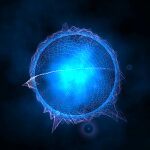Link to Pubmed [PMID] – 1805136
Pathol. Biol. 1991 Dec;39(10):1029-37
Secondary ion mass spectrometry (SIMS) microscopy provides a direct mapping of 127I in thyroid follicles. Thyroid tissue should be fixed and embedded in methacrylate resin, then cut in 3 microns-thick sections which are placed on a gold coverslip. The histological structure of the tissue is determined by the phosphorus ion (31P) which is present in large amounts in nuclei and phosphorylated molecules in the cytoplasm. An image processing system is used to superimpose images of 127I and 31P: this system allows measurement of local concentration of 127I in the follicular cell and follicular lumen compartments. A study in 8 subjects with normal thyroid glands showed that the level of 127I within follicular cells (430 +/- 250 micrograms/g; m +/- SE) was 6 to 7 times lower than the level in the follicular lumen (2.780 +/- 230 micrograms/g). In simple goiter (9 patients with macrofollicular adenomas), follicular lumen (346 +/- 17 micrograms/g) and cellular (68 +/- 6 micrograms/g) concentrations of 127I were decreased fivefold but the ratio of concentrations remained similar to that seen in normal tissue. In hyperfunctioning nodules (2 microfollicular and 3 macrofollicular adenomas), follicular cell and follicular lumen 127I levels varied widely and showed considerable overlap (2 to 16,000 micrograms/g and 1-21,000 micrograms/g, respectively). In benign cold nodules (1 microfollicular adenoma and 2 macrofollicular adenomas), follicular cell and follicular lumen 127I levels were barely detectable (3 +/- 0.6 micrograms/g and 6 +/- 0.7 micrograms/g respectively). In the 9 malignant nodules studied, no difference in 127I level profile was found with benign nodules.(ABSTRACT TRUNCATED AT 250 WORDS)

